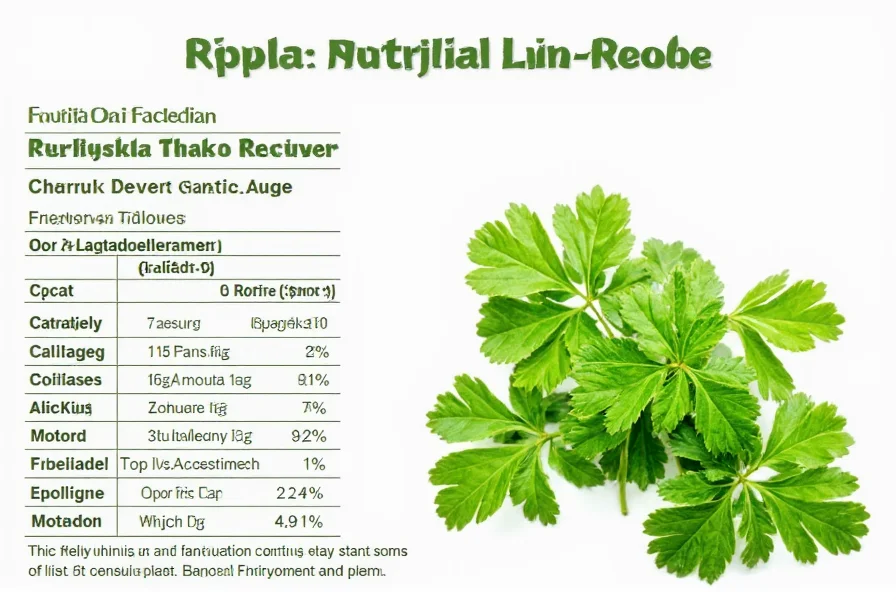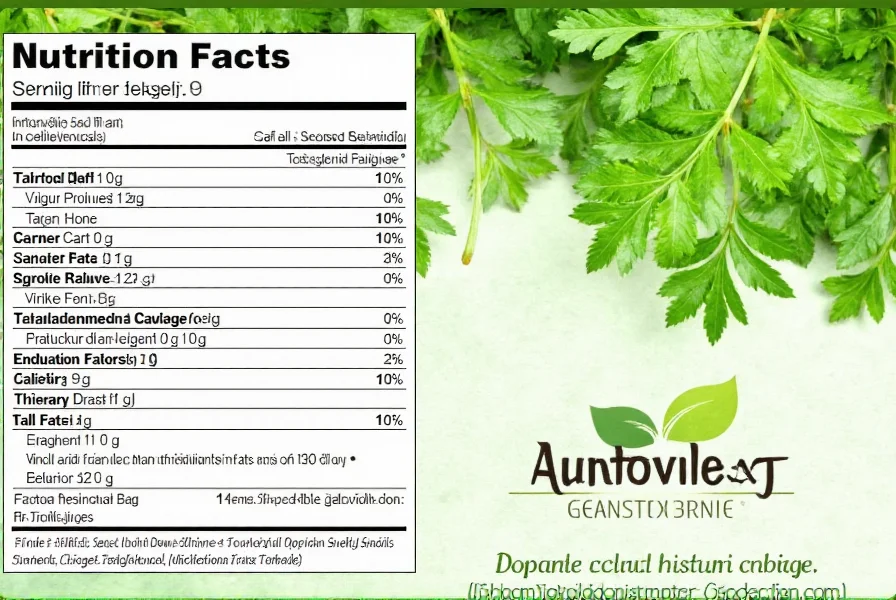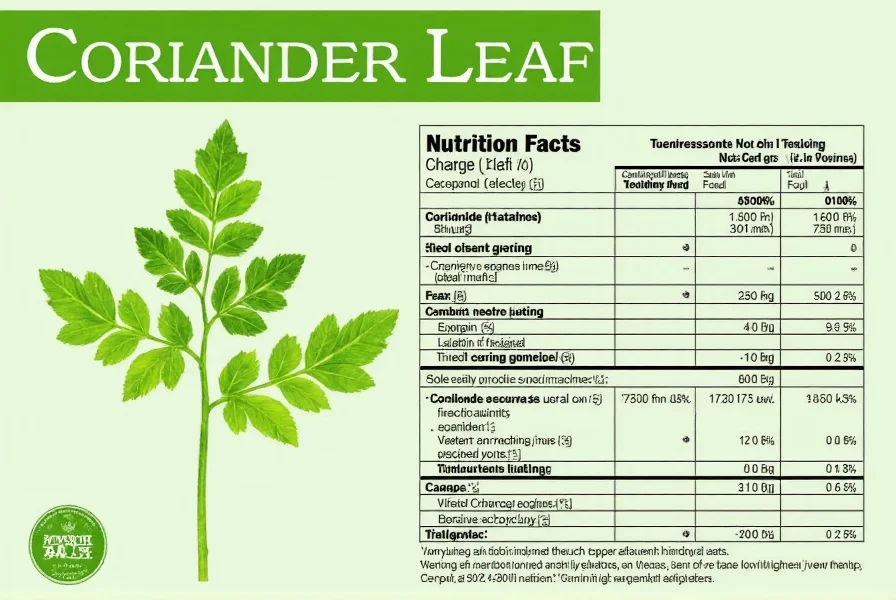Nutritional Profile of Coriander Leaves: A Comprehensive Analysis
Coriander leaves, scientifically known as Coriandrum sativum, represent one of nature's most nutrient-dense culinary herbs. Unlike their seed counterparts (coriander seeds), the fresh leaves deliver a unique nutritional composition that makes them valuable for daily dietary inclusion. Understanding coriander leaf nutrition facts helps maximize their health benefits while incorporating them into regular meal planning.
Essential Nutrients in Coriander Leaves
Per 100 grams of raw coriander leaves, the nutritional breakdown reveals impressive concentrations of essential vitamins and minerals. This fresh herb contains minimal calories yet delivers substantial micronutrients that contribute significantly to daily recommended values.
| Nutrient | Amount per 100g | % Daily Value* |
|---|---|---|
| Calories | 23 kcal | 1% |
| Protein | 2.1 g | 4% |
| Dietary Fiber | 2.8 g | 10% |
| Vitamin A | 6748 IU | 135% |
| Vitamin C | 27 mg | 45% |
| Vitamin K | 310 mcg | 387% |
| Folate | 62 mcg | 16% |
| Calcium | 67 mg | 7% |
| Potassium | 521 mg | 15% |
| Manganese | 0.3 mg | 13% |
*Percent Daily Values based on a 2,000 calorie diet
Health Benefits Supported by Coriander Leaf Nutrition
The impressive nutritional composition of coriander leaves translates to several evidence-based health benefits. Unlike many herbs that offer primarily flavor with minimal nutritional impact, coriander leaves deliver substantial health-promoting compounds.
Antioxidant Powerhouse
Coriander leaves contain numerous antioxidants including quercetin, kaempferol, and various polyphenols. These compounds combat oxidative stress and reduce inflammation throughout the body. Research published in the Journal of Agricultural and Food Chemistry confirms coriander's significant antioxidant capacity, which helps protect cells from damage caused by free radicals.
Bone Health Support
With exceptionally high vitamin K content (providing over 387% of the daily recommended value per 100g), coriander leaves significantly contribute to bone metabolism and calcium absorption. Regular consumption supports bone mineral density and reduces fracture risk, particularly important for aging populations.
Cardiovascular Protection
The combination of potassium, dietary nitrates, and antioxidants in coriander leaf nutrition profile supports healthy blood pressure regulation and vascular function. Potassium helps counterbalance sodium effects, while nitrates convert to nitric oxide in the body, promoting blood vessel dilation.
Maximizing Nutritional Benefits in Your Diet
To fully benefit from coriander leaf nutrition facts, proper handling and preparation techniques matter significantly. Unlike many vegetables, coriander leaves lose nutritional value when cooked extensively.
Optimal Consumption Methods
For maximum nutrient retention, add fresh coriander leaves at the end of cooking or use them raw in:
- Salsas and chutneys
- Salad toppings
- Smoothies
- Garnishes for soups and stews
Chopping coriander leaves and allowing them to sit for 5-10 minutes before consumption can increase the availability of certain beneficial compounds through enzymatic action.
Storage Techniques for Nutrient Preservation
Proper storage maintains coriander leaf nutritional value:
- Store fresh coriander in the refrigerator with stems in water (like flowers)
- Cover loosely with a plastic bag
- Change water every 2-3 days
- Use within 7-10 days for optimal nutrient content

Coriander Leaves vs. Other Culinary Herbs
When comparing coriander leaf nutrition to other common herbs, it stands out for specific nutrient concentrations:
- Vitamin K: Significantly higher than parsley and substantially more than basil
- Vitamin A: Contains more beta-carotene than mint or dill
- Antioxidant capacity: Higher ORAC (Oxygen Radical Absorbance Capacity) value than chives
While all fresh herbs contribute valuable nutrients, coriander's unique nutritional signature makes it particularly valuable for specific health considerations.
Special Considerations for Coriander Consumption
Understanding potential interactions and individual responses to coriander leaf nutrition ensures safe and effective consumption.
Genetic Factors and Taste Perception
Approximately 21% of the population carries a genetic variation that causes coriander to taste soapy. This doesn't affect nutritional value but may impact consumption willingness. For those affected, incorporating coriander into cooked dishes or using smaller quantities blended with other herbs can improve acceptance.
Heavy Metal Chelation Properties
Research suggests coriander may help remove certain heavy metals from the body. While this represents a potential benefit, individuals undergoing chelation therapy should consult healthcare providers about potential interactions.

Practical Applications of Coriander Leaf Nutrition
Incorporating coriander leaves into daily meals provides measurable nutritional benefits without significant calorie addition. Consider these practical applications:
- Add 10g (about 1/4 cup chopped) to morning smoothies for vitamin K boost
- Use as primary green in salads (replacing less nutrient-dense lettuce)
- Create coriander pesto as a nutrient-rich alternative to traditional basil pesto
- Infuse in water or tea for mild flavor and antioxidant benefits
For individuals monitoring blood clotting (such as those on warfarin therapy), consistent daily consumption of coriander leaves is preferable to irregular large servings due to the high vitamin K content.
Understanding Coriander Leaf Nutrition: Evidence-Based Insights
The nutritional value of coriander leaves extends beyond basic vitamin and mineral content. Research continues to uncover how these compounds interact within the human body. Unlike synthetic supplements, the naturally occurring compounds in fresh coriander work synergistically, enhancing bioavailability and effectiveness.
When evaluating coriander leaf nutrition information online, look for sources that cite peer-reviewed research rather than making exaggerated health claims. The most reliable information comes from agricultural universities, government nutritional databases, and published clinical studies.
How much coriander should I eat daily to benefit from its nutrition?
For significant nutritional impact, aim for 10-30g (approximately 1/4 to 3/4 cup chopped) daily. This amount provides meaningful vitamin K and antioxidant benefits without excessive intake. Consistent daily consumption delivers better results than occasional large servings.
Does cooking destroy the nutritional value of coriander leaves?
Yes, cooking reduces certain nutrients in coriander leaves, particularly vitamin C and some antioxidants. For maximum nutritional benefit, add fresh coriander at the end of cooking or use it raw. Light cooking preserves most vitamin K and mineral content while reducing the soapy taste perception for those genetically predisposed.
Can coriander leaves help with digestion?
Yes, coriander leaves contain compounds that stimulate digestive enzyme production and may relieve bloating and gas. The dietary fiber content also supports healthy digestion. Traditional medicine systems have used coriander for digestive issues for centuries, and modern research supports these applications.
Are there any risks associated with consuming coriander leaves?
Coriander leaves are generally safe for most people when consumed in food amounts. Those on blood-thinning medications should maintain consistent intake due to high vitamin K content. Rarely, some individuals may experience allergic reactions. The soapy taste perception (a genetic trait) doesn't indicate any health risk but may affect consumption.
How does dried coriander compare nutritionally to fresh coriander leaves?
Dried coriander (often called coriander leaf powder) has concentrated minerals but significantly reduced vitamin C and some volatile compounds compared to fresh leaves. Fresh coriander provides higher levels of water-soluble vitamins and more vibrant flavor compounds. For maximum nutritional benefit, fresh is preferable, though dried still offers valuable nutrients.











 浙公网安备
33010002000092号
浙公网安备
33010002000092号 浙B2-20120091-4
浙B2-20120091-4